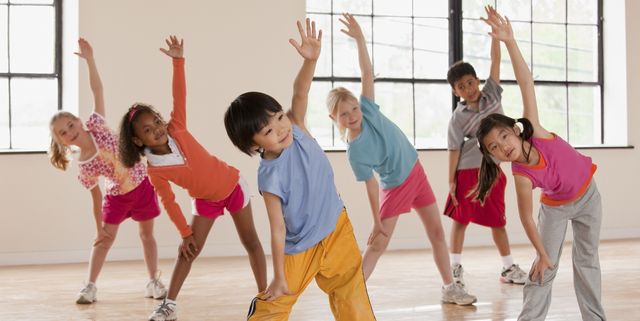Running
 FatCamera//Getty Images
FatCamera//Getty ImagesIt may seem the simple, but chasing each other around is one of the best exercises kids can do. "Running is particularly healthy for kids, since it helps them build strong bones while strengthening their muscles," Oldham says. "Not to mention, it’s fun to run. Coupled with a healthy diet, it helps children maintain a healthy weight. Developing a love of running and seeing it as fun is something children can carry into adulthood, setting them up for a lifetime of healthy habits." Playing tag, organizing timed relays, or games like Mother May I? or What Time Is It, Mr. Fox? will get your kids up and racing.
RELATED: Fun Toddler Activities That Give Their Bodies and Brains a Boost
Squats
 SDI Productions//Getty Images
SDI Productions//Getty ImagesOldham notes that squats help kids build endurance, strength, and even self-confidence. She likes to play a game called Hot Seat Squats. "Place a stool or ottoman behind them while they squat, let their bum — or biscuits — graze the seat of it, then quickly stand. We call these Hot Seat Squats because you don’t want your biscuits to get burned! You simply toast them. Most kids find them super fun because almost all kids are capable of successfully executing this exercise."
Advertisement - Continue Reading Below
Skipping
 stevecoleimages//Getty Images
stevecoleimages//Getty ImagesNot only does skipping increase heart rate, work out the total body, and improve core strength, it's also an unexpected workout for little minds as well. "Skipping is a fantastic brain booster!" Oldham says. "It engages both the left and right brain, leading to improved functioning, while improving balance and coordination."
RELATED: Backyard Games for Kids That Will Get the Whole Family up and Moving
Crab Walk
 RuslanDashinsky//Getty Images
RuslanDashinsky//Getty ImagesYou know how to do these: Have your kids sit with their feet in front and hands behind, then lift their hips off the ground so they're walking like a crab. It's funny and silly, while also developing core and arm strength. Once your kids have mastered the basic move, kick it up a notch: "Try balancing different small items on their bellies while moving around," she says. "At The Little Gym, we balance bean bags and shakers. At home, you could try toilet paper rolls, snack-size bags of pretzels, or even your favorite stuffed animal!"
Advertisement - Continue Reading Below
Bear Crawl
 BraunS//Getty Images
BraunS//Getty ImagesIf they don't like walking like a crab, flip it over and have them walk like a bear — have them crawl on their hands and feet, with their knees not touching the ground. "The bear walk is what we call a 'whole body' skill because it works the entire body at once," Oldham says. "It starts with strengthening the core to weight-bearing, which strengthens the arms ands legs. It also enhances the child’s spacial awareness. It’s a full brain and body exercise." Bear walk races are always popular, Oldham says, but parents can also sneak these in whenever they can. "Rather than walking to the bathroom for bathtime, why not bear crawl?" she says.
"Supermans"
 Robert Niedring//Getty Images
Robert Niedring//Getty ImagesHave your kid lay on their bellies, then lift their arms and feet off the ground, a la Superman flying through the air. It's a good movement — if it's done correctly, Oldham warns. "Supermans improve the back, neck, glutes, and hamstrings, and they're also a great got improving the vestibular system," she says. "But they can also put a lot of strain on the areas if not performed correctly."
Advertisement - Continue Reading Below
Frankenstein Walk/Cross-Lateral Movement
 Mary Knox Merrill//Getty Images
Mary Knox Merrill//Getty ImagesCross-lateral movements involve crossing one side of the body over to the other, such as knee/elbow exercises where the left elbow touches the right knee, and so on. "Cross-lateral movements improve brain function, focus, and coordination," she says. The "Frankenstein Walk" asks kids to put their hands straight out like Frankenstein's monster (or a zombie), then bring one leg out straight so it's almost parallel with the ground. The object is to touch the toe with the opposite hand. Growling like a monster is optional.
Stretching and Yoga
 LanaStock//Getty Images
LanaStock//Getty ImagesThere are many advantages to stretching, including reducing the risk of injury, increasing range of motion, and keeping muscles flexible and strong. But most importantly, Oldham says, stretching has been proven to reduce stress. "At The Little Gym, we perform what we call a 'Beautiful Butterfly' with the kids to stretch the body while centering their focus," she says. "Simply sit on the floor, bring the soles of your feet together in front of you, making the shape of your legs into butterfly wings. Then you breathe in as you lift your arms over your head, and as you release the arms back down, you breathe out." It's a soothing way to begin or end a day.

Marisa (she/her) has covered all things parenting, from the postpartum period through the empty nest, for Good Housekeeping since 2018; previously, she wrote about parents and families at Parents and Working Mother. She lives with her toy-collecting husband and daughter in Brooklyn, where she can be found helping out her team at bar trivia or posting about movies on Twitter and Bluesky.
Advertisement - Continue Reading Below
Advertisement - Continue Reading Below
Advertisement - Continue Reading Below






















